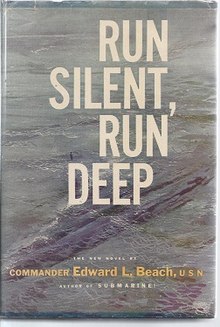Run Silent, Run Deep

Run Silent, Run Deep is a novel by Commander (later Captain) Edward L. Beach Jr. published in 1955 by Henry Holt & Co.[1] Run Silent, Run Deep is also the name of a 1958 film of the same name starring Clark Gable and Burt Lancaster. The story describes World War II submarine warfare in the Pacific Ocean, and deals with themes of vengeance, endurance, courage, loyalty and honor, and how these can be tested during wartime. The name refers to "silent running", a submarine stealth tactic.
It was the first of Beach's 13 novels. He told an interviewer that writing, for the most part, came easily:[2]
Things have to happen, one thing happens after another. All of a sudden you come to an impasse, damn it, and you throw it away and start over again. The subs [Submarine!, 1952, nonfiction] I did okay, but writing about women–I never had so much trouble in my life as with this one.
The novel was on The New York Times Book Review list for several months. The staff of the New York Times Book Review included it on their list of 250 Outstanding Books of the Year.[3] Beach served on submarines in the Pacific Ocean during the war, and this adds to the realism of the story. He composed two sequels to Run Silent, Run Deep: Dust on the Sea (1972), a third person narrative detailing later patrols of the Eel;[4] and Cold is the Sea (1978), about the same protagonist's later service on a nuclear-powered submarine in 1960.[citation needed]
Run Silent, Run Deep proved to be the best known of Beach's novels.[5]
Plot
The narrative is presented as the transcript of a Navy tape recording made by Commander Edward J. Richardson, recounting the events resulting in his receipt of the Medal of Honor. The prefatory note that purports to identify the text in this way says it was meant to be used in a war bond drive, but is unsuitable for that because Richardson "failed to confine himself to pertinent elements of the broad strategy of the war, and devoted entirely too much time to personal trivia."
In the spring of 1941, Richardson takes command of a World War I S-16, a submarine retired in 1924, and soon has Jim Bledsoe as his executive officer. They and their crew work at the Philadelphia Navy Yard to fit out and commission her, and in August take her to New London, Connecticut, for training. There he meets Bledsoe's girlfriend, Laura Elwood. The three of them are together when they learn of the attack on Pearl Harbor. Though it took Richardson three years of submarine duty to qualify for command, the war and the prospect of many more submarines coming into service lead Richardson, against his better judgment, to recommend Bledsoe for command in late December, just after learning that Bledsoe and Laura plan to wed. Richardson is forced to withdraw his recommendation of Bledsoe when he performs recklessly on his qualification for command, nearly sinking their boat. Bledsoe is resentful, and Laura despises Richardson for ruining Bledsoe's chance for a command. Richardson and his crew are soon assigned to a newly launched submarine, the USS Walrus, and take her to Pearl Harbor to destroy Japanese shipping in the Pacific Ocean. Laura and Jim wed just before the Walrus departs New London.
During their first war patrol in the Walrus, they encounter the Japanese destroyer Akikaze, skippered by Captain Tateo Nakame (nicknamed "Bungo Pete"), who is responsible for sinking a series of American submarines in the Bungo Suido, including the USS Nerka, commanded by a close friend of Richardson's. Richardson is wounded in an encounter with Bungo and remains at Pearl Harbor while Bledsoe commands the Walrus for three war patrols. Bledsoe establishes a reputation as an aggressive skipper with a good record for sinkings. Between patrols, Bledsoe has an extramarital affair at Pearl Harbor, causing Richardson anguish for Laura's sake. During its next patrol, however, Bungo Pete makes the Walrus his seventh victim.
During his stint ashore, Richardson works on reliability problems with American torpedoes and receives a new command, USS Eel. When the news of the loss of Bledsoe and the Walrus arrives, Richardson convinces his superiors to let him hunt Bungo Pete in the Eel. A great battle ensues in a raging storm between the Eel, fighting on the surface, and Bungo Pete's special anti-submarine warfare group, which consists of a Q-ship, a Japanese submarine, and the Akikaze. After Richardson sinks all three vessels, he discovers three lifeboats in the vicinity and realizes that Bungo Pete and his skilled specialists will be rescued to resume hunting U.S. vessels. He intentionally rams the lifeboats.
Soon after, the Eel is detailed to lifeguard duty off Guam, where Richardson saves three aviators, earning him the Medal of Honor. After the war he returns home, hoping to begin a relationship with Laura Bledsoe.
References
- ^ Mitgang, Herbert (April 3, 1955). "Deep Down And Deadly". New York Times. Retrieved February 9, 2014.
- ^ Breit, Harvey (April 3, 1955). "In and Out of Books". New York Times. Retrieved February 9, 2014.
- ^ "A List of 250 Outstanding Books of the Year". New York Times. December 4, 1955. Retrieved February 9, 2014.
- ^ "Dust on the Sea". New York Times. October 22, 1972. Retrieved February 9, 2014.
- ^ Goldsrein, Richard (December 2, 2002). "Edward L. Beach, Author and First Round-the-World Submariner, Dies at 84". New York Times. Retrieved February 9, 2014.
Further reading
External links
- Book Review – J.T. Daniel Official website
- Book review – SubSim.com
